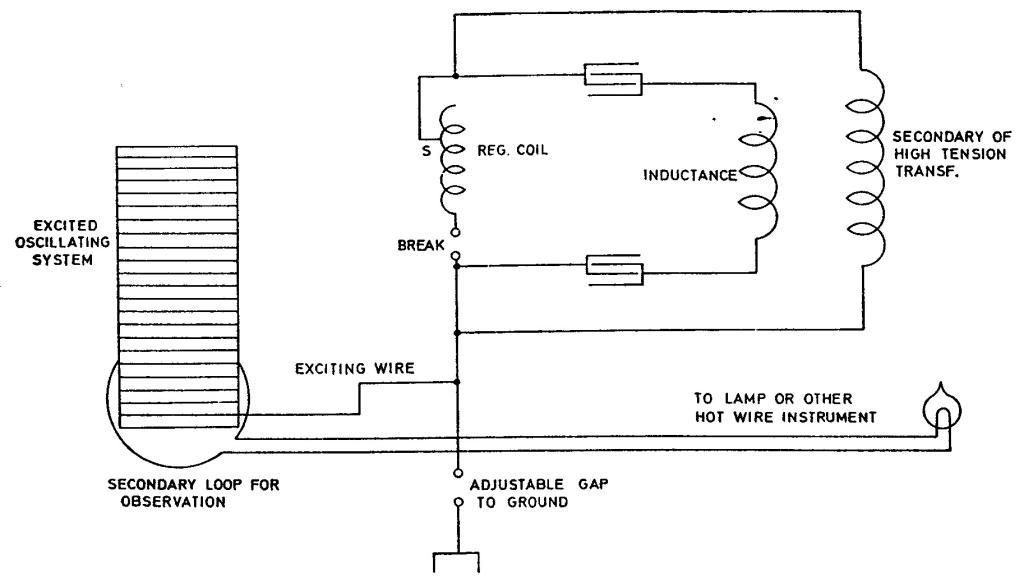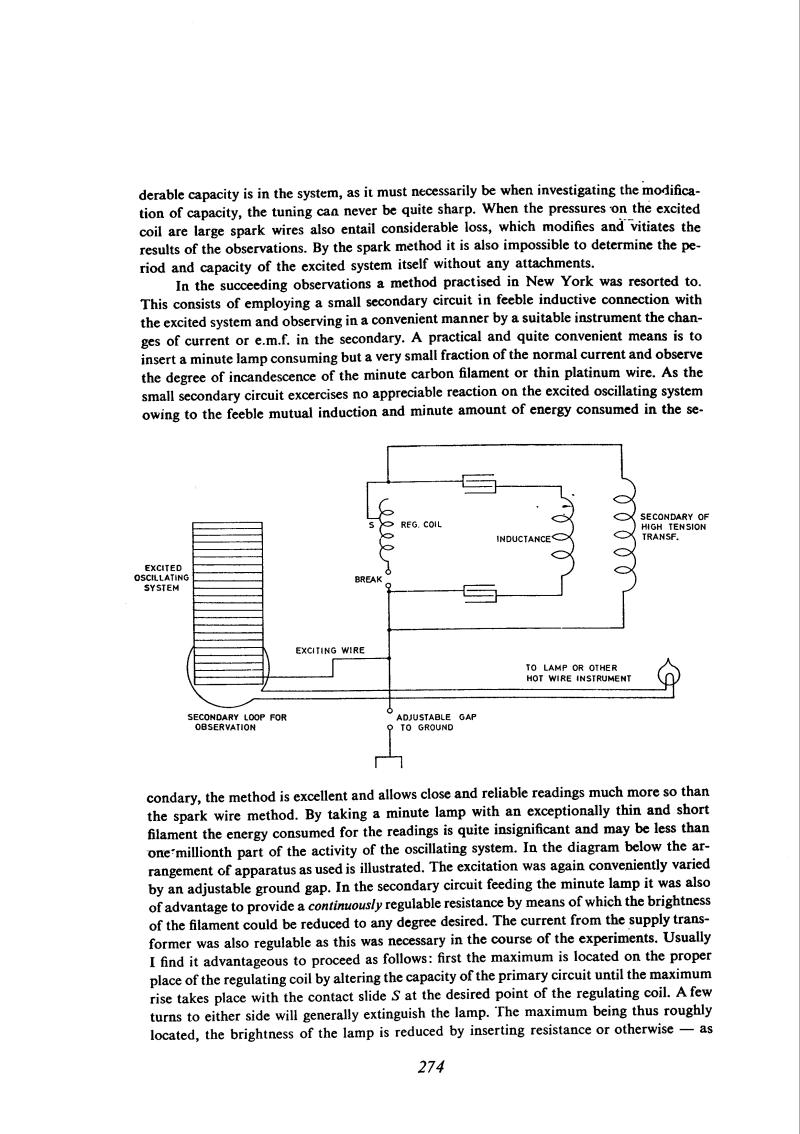
Nikola Tesla Books
derable capacity is in the system, as it must necessarily be when investigating the modification of capacity, the tuning can never be quite sharp. When the pressures on the excited coil are large spark wires also entail considerable loss, which modifies and vitiates the results of the observations. By the spark method it is also impossible to determine the period and capacity of the excited system itself without any attachments.
In the succeeding observations a method practised in New York was resorted to. This consists of employing a small secondary circuit in feeble inductive connection with the excited system and observing in a convenient manner by a suitable instrument the changes of current or e.m.f. in the secondary. A practical and quite convenient means is to insert a minute lamp consuming but a very small fraction of the normal current and observe the degree of incandescence of the minute carbon filament or thin platinum wire. As the small secondary circuit exercises no appreciable reaction on the excited oscillating system owing to the feeble mutual induction and minute amount of energy consumed in the secondary, the method is excellent and allows close and reliable readings much more so than the spark wire method.
By taking a minute lamp with an exceptionally thin and short filament the energy consumed for the readings is quite insignificant and may be less than one millionth part of the activity of the oscillating system. In the diagram below the arrangement of apparatus as used is illustrated. The excitation was again conveniently varied by an adjustable ground gap. In the secondary circuit feeding the minute lamp it was also of advantage to provide a continuously regulable resistance by means of which the brightness of the filament could be reduced to any degree desired. The current from the supply transformer was also regulable as this was necessary in the course of the experiments. Usually I find it advantageous to proceed as follows: first the maximum is located on the proper place of the regulating coil by altering the capacity of the primary circuit until the maximum rise takes place with the contact slide S at the desired point of the regulating coil. A few turns to either side will generally extinguish the lamp. The maximum being thus roughly located, the brightness of the lamp is reduced by inserting resistance or otherwise - as
274
November 10
Had Tesla published the measuring methods he developed in New York and Colorado Springs, his name would probably be frequently encountered in earlier textbooks and handbooks on electrical measurements at high frequencies. As it is, we can only remark his exceptional ingenuity in designing measuring devices and the accuracy with which he determined the resonance of oscillatory circuits. An especially interesting feature is his method using a lamp already heated up by a supplementary power source, greatly increasing its sensitivity to small amplitude changes around the resonance peak of the oscillatory circuit.
November 10
He winds a new coil with 1314 turns on the same core on which he wound 689 turns (please see Oct. 18) and later 346 turns (please see Oct. 31). With this coil he measures the metal sphere capacitance again and achieves a similar value as on November 7, with "additional coil". At the end of these measurements and calculations he establishes that the method of resonance determination on the basis of spark length in the arc gap is not quite satisfactory. In the following experiments he changes the resonance determination procedure. He returns to a method which he applied earlier in the New York laboratory. That method was based on the use of an auxiliary secondary coil, in a weak inductive link with excitation system, at which terminal is the instrument for the registration of current or voltage change in the secondary. usually for the registration of changes a small bulb was used. The variation of the method is particularly interesting where the small bulb is preheated by means of a D.C. current (please see Fig. 2). The preheated bulb could register very small excitation changes from the high frequency direct current circuit, which are applied to additionally heat up the already preheated filament in order to emit visual light.
By using the newly applied method of resonance indication he performs some measurements again and he measures the capacitance of a vertical wire 50 ft. in length. After this he switches over to determine the coil self-capacitance with 1314 turns. The measured result he compared with the calculated one for the capacitance of a metal cylinder of the same shape as the coil. According to Tesla, this serves only as a rough estimate. When they are using the entire coil length in the first calculation, he obtained a higher value than measured, he takes the effective coil length on the basis of bare wire. It is obvious that Tesla looks for orientation of the theoretical equations in order to be able to estimate parameters, but the experiment is the most effective factor. As far as the problem of determining the coil self capacitance, this is evident from the first days of the notes (please see eg. June 20, July 3, etc.)


